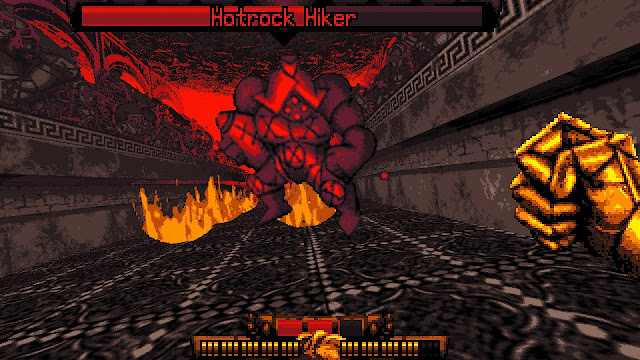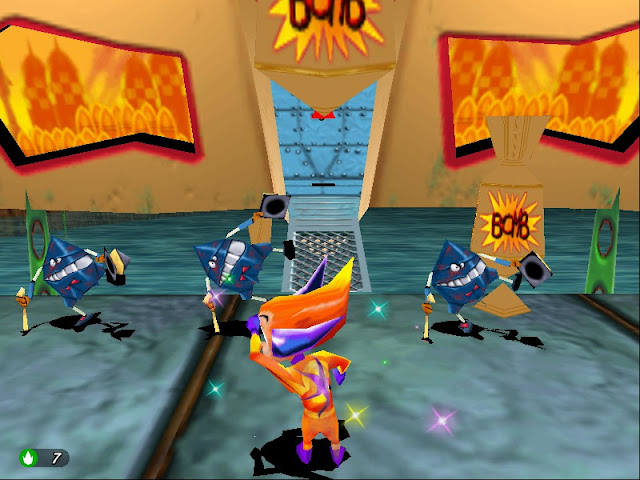Fight Knight Review | Uppercutting your way to victory
One kind of games I always find intriguing are those who set on to mix two seemingly incompatible genres.
It's interesting to see what kind of solutions someone used to tackle so many design challenges and to ponder whether the end result will be just a nice but ultimately inconsequential experiment or a breakthrough to something greater.
Fight Knight belongs to this kind of games.
Aesthetics
 |
Mind your steps in the swamp |
I was struck by the looks, it uses 2.5 rendering for the characters similarly to classic Doom, with the heavy usage of sprites always looking at the player no matter the direction, except for the environments, they are fully modelled. This mixed with a colorful palette and very prominent lines give the game a unique look that makes it stand out.
Most of the animations consists of a couple of frames at most, but they don't look bad at all, in fact the stylized looks make them quite appealing and easy to read, and since this is a game that requires fast reflex, it's a perfect fit.
There isn't any kind of voice acting, rather all characters make a unique sound.
The soundtrack switches based on the context the player is in, depending on the area you are in, who is talking to, if you are in exploration or fight mode, the music is going to be different. It's very catchy, varying from soothing and relaxing, mysterious and ambient, epic and fast, and in some situation even creepy. It even distorts itself if you take damage during combat, making it very clear when you mess up.
In short, the game has an uncommon style and it has good audio too.
Game Mechanics
 |
The automap helps to avoid confusion while also not hand-holding the player |
The title is a dungeon crawler with a very peculiar combat system: instead of encountering and fighting monsters in the dungeon itself, the encounters are randomized and teleports the player into an endless corridor with two aisles where the player must brawl against a random amount (between 1 and 8) of enemies in a real time action sequence. Because of this peculiarity, the developers themselves have baptized the game as a "dungeon brawler".
In details, when fighting, the player has 5 possible actions to perform: fast attacks, charged attacks, special attacks, block and move around. Fast attack are the most common form and are executed by rapidly pressing the space bar (in case of a motor disability, there is an accessibility option: by pressing the V key, the main character will do rapid attacks constantly without needing to do any fast pressing). Charged attacks are executed by holding the space bar, they do more damage, but are also slower to perform. Special attacks activate a mini-game which, if executed perfectly, is going to do massive damage and also a special effect, like stunning all the enemies. Special attacks are limited by the bar above the health, once that runs out, they can't be performed until it is refiled, either by fighting or resting. Blocking will make the character take less damage and if executed just right before an enemy's attack, it will also count as parry, stunning the enemy or sending back a thrown projectile. Moving around can make the player avoid damage entirely, but can also be mixed with the attacks to create a deadly combo, for example, attacking after backing up is going to make the player character do a powerful uppercut.
This set of tools make the fights adrenaline fueled and fun, plus the new stuff gets unlocked at a reasonable pace.
Beyond the fights, there is exploration in the over world. Here, it's where the other half of the play time is passed, mainly solving environmental puzzles, like finding the safe path in a desert, least you get swallowed by the sands. Also, I appreciated the fact that there are no multi-level puzzles, like bringing a key from a floor to another one, it's one aspect I don't enjoy in old-school dungeon crawlers inspired titles.
While it took me a bit to figure them out, I never felt frustrated by the puzzles and managed to solve them without needing help.
There are 6 levels in total, each one follows a theme and builds its puzzle challenges on it, like one where you need to swap between transforming the terrain into almost unwalkable lava or slippery ice. Each of them has a boss fight at the end, making you test everything you have learned.
Moving onto the economy, your main resources are: the loot dropped by defeated enemies, recipes that unlock new special attacks and armor pieces that, once found the entire set of 3 and brought to the blacksmith in town, will unlock a new armor to equip.
More on the town, there are 4 points of interest: the ship, the potion shop, the library and the forge.
On the ship, you either sleep to save your progress and refill your health/special attacks bar, or you can ask the cook to make you a dish which will equip a max of 3 special attacks, you can unlock new special attacks by giving him the recipes + some loot. Keep in mind, sleeping is the only way to save, it's possible to lose a good chunk of your progress if you're not careful and die suddenly. The potion shop can give you as many potions as you can carry for free, as long as you have unlocked that particular potion you want by giving the necessary loot to the potion maker and have enough space in the inventory, this last one is expandable by finding the pupils of the potion maker in the dungeon and bring them to him. Depending on who is residing in the library, you can find an explorer mantis lady who, when given an item from a defeated enemy, gives you tips on how to defeat said enemy. Lastly, the forge is where you can get and swap armor sets. My favorite armor was one that could steal the life from enemies and give it to you, increasing self sustainability.
Enemy wise, it's very varied, each level has a set of 6+ types of foes with a clear set of skills, strengths and weaknesses. Each of those foes require a dedicated strategy to be defeated, sometimes even multiple ones, since it can happen to face a nasty combination that can be a real nuisance. For instance, later in the game, you will encounter 2 kinds of enemies: one that can immobilize you and another one that shoots you from distance. While alone are not a threat, combined represent a problem since they can grind you out. In addition, the foes can get in angry state which makes them deal and suffer extra damage, creating some high risk/high reward tensions.
While the base game doesn't have any kind of difficulty selector, there is an option of new game plus, which is much harder, and also has some exclusive elements, like glyphs that take space in the potions menu and grant passive buffs.
I finished the game in 10 hours and a half.
Summarizing, the mechanics offered give a spin to well established dungeon crawling ideas in an interesting and fun way.
Narrative
 |
The antagonist taunting the Fight Knight |
Once upon a time, in a far, far away island, a cursed tower arose from the ground, said to swallow anyone who dares enter it, and bringing an eternal night. Few dare to enter, but one fearless knight has to, for he has unfinished business with the master of the tower.
From here the main adventure starts in the shoes of the protagonist, the Fight Knight, as he ascends to the tower.
Mood wise, the game is a collage of various themes, quite similar to many modern indie titles: you have a sense of adventure, awe of exploration, hints of mystery, notes of tragic, a bit of creepy stuff, a chunk of wholesome and cute, and a reunion ending with all the characters that will make you feel all warm and fuzzy in the inside.
This is a very like it or hate it situation. I enjoyed it, but I could see someone not liking it and wanting something a bit more focused, or something that analyzes unexplored themes.
There are few characters, but each of them has a unique personality. Some of them have dedicated arcs in which they are given a bit of introspection of themselves. Some that remained impressed in me were the Nightwatch men, which I nicknamed the himbo squad due to the fact of being beefy both in the muscles and in the head, while also possessing a strong sense of brotherhood, companionship and duty (after a good night of sleep of course). Another memorable interaction is the one with one of the first characters you are going to meet: the lady Mantis librarian. She is looking for her explorer sister, who recklessly entered the tower. She and her sister have an almost constant presence in the game and will share thoughts about the other one, constantly unraveling the shifting feelings one has for the other. When at the library, you can give the librarian the parts of defeated enemies to hear some trivia about said enemies. Nothing breathtaking, but cool to hear nonetheless.
Lore wise, there are hints here and there about the backstory of each individual level of the tower delivered by standing NPCs and subtle props. I didn't grasp it fully in the end, a second run with the benefit of hindsight may make everything more clear and make it see all the world building better.
In conclusion, while the game uses some tropes of modern indie games, it does so in a compelling and charming way.
Recommendation:
Fight Knight heartfelt production and out of the ordinary gameplay make it a compelling choice for any indie lover.
Available on Steam.




Comments
Post a Comment